2014 FORD F150 steering wheel
[x] Cancel search: steering wheelPage 7 of 41

•Longer, cast aluminum lower controlarms
•Longer, forged steel upper control arms
•Front coil springs and rear leaf springs
•Fox Racing 1.8 inch piston internalbypass front shocks
•Fox Racing 1.8 inch, internal bypass,remote reservoir rear shocks
•Micro-cellular urethane jouncebumpers (front and rear)
•Raptor navigation welcome screen
•Full-size all-terrain spare tire
•Off-road specific calibrations forengine, transmission and AdvanceTracsystem
•Standard 17 inch Cast AluminumWheels
•Optional 17 inch forged aluminumbeadlock compatible wheels
•LT 315/70-17 BF Goodrich all-terraintires
Note:Your F-150 SVT Raptor is equippedwith unique front and rear high-performanceFox shock absorbers designed for severeoff-road use. Due to the hydraulic motionof the shock fluid in the unique internalbypass system, you can expect some noiseduring on-road driving, including boom,chirp, or clunk noises. This is a normalcharacteristic of the shock absorbers andyou should not attempt repair.
F-150 SVT Raptor-Specific Interior Features
•Instrument panel cluster graphics
•High line LCD cluster with unique SVToff-road screen
•Steering wheel - unique wrap withon-center marker, thumb pads andimproved grip contour
•Door trim inserts and center stack trim
•Off-road style floor mats with SVT logo
5F150 (TF6)At a GlanceE167332
Page 12 of 41
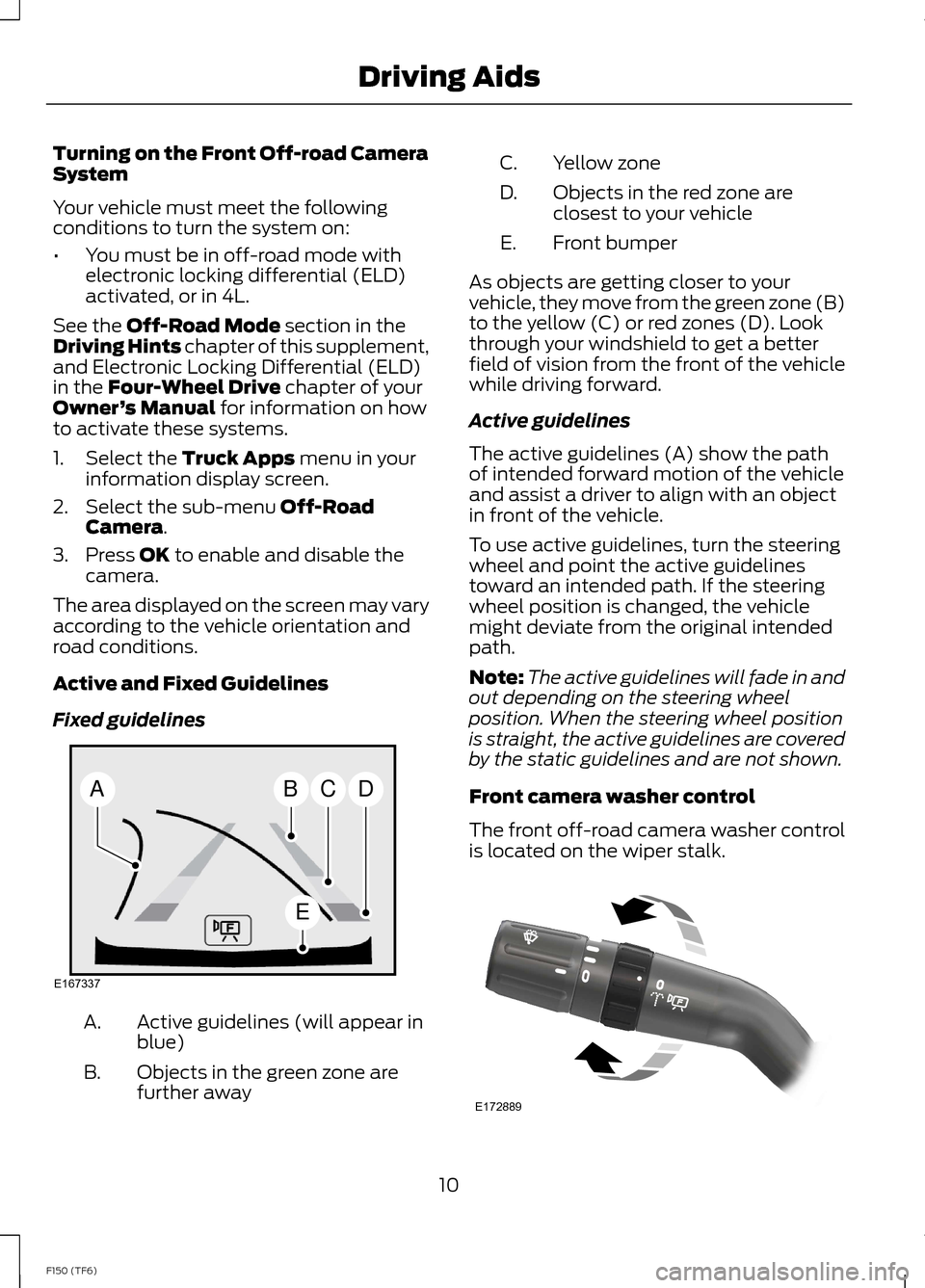
Turning on the Front Off-road CameraSystem
Your vehicle must meet the followingconditions to turn the system on:
•You must be in off-road mode withelectronic locking differential (ELD)activated, or in 4L.
See the Off-Road Mode section in theDriving Hints chapter of this supplement,and Electronic Locking Differential (ELD)in the Four-Wheel Drive chapter of yourOwner’s Manual for information on howto activate these systems.
1.Select the Truck Apps menu in yourinformation display screen.
2.Select the sub-menu Off-RoadCamera.
3.Press OK to enable and disable thecamera.
The area displayed on the screen may varyaccording to the vehicle orientation androad conditions.
Active and Fixed Guidelines
Fixed guidelines
Active guidelines (will appear inblue)A.
Objects in the green zone arefurther awayB.
Yellow zoneC.
Objects in the red zone areclosest to your vehicleD.
Front bumperE.
As objects are getting closer to yourvehicle, they move from the green zone (B)to the yellow (C) or red zones (D). Lookthrough your windshield to get a betterfield of vision from the front of the vehiclewhile driving forward.
Active guidelines
The active guidelines (A) show the pathof intended forward motion of the vehicleand assist a driver to align with an objectin front of the vehicle.
To use active guidelines, turn the steeringwheel and point the active guidelinestoward an intended path. If the steeringwheel position is changed, the vehiclemight deviate from the original intendedpath.
Note:The active guidelines will fade in andout depending on the steering wheelposition. When the steering wheel positionis straight, the active guidelines are coveredby the static guidelines and are not shown.
Front camera washer control
The front off-road camera washer controlis located on the wiper stalk.
10F150 (TF6)Driving AidsBECDAE167337 E172889
Page 21 of 41

Off-road Screen
The real-time status of your vehiclesoff-road systems can be continuouslymonitored using the first off-road screenfound under the Truck Apps menu in theinformation displays screen. See theInformation Displays chapter of yourOwner’s Manual for more information.
Basic Off-road Driving Techniques
•
•Grip the steering wheel with thumbson the outside of the rim. This willreduce the risk of injury due to abruptsteering wheel motions that occurwhen negotiating rough terrain. Do notgrip the steering wheel with thumbsinside the rim.
•Throttle, brake and steering inputsshould be made in a smooth andcontrolled manner. Sudden inputs tothe controls can cause loss of tractionor upset the vehicle, especially whileon sloped terrain or while crossingobstacles such as rocks or logs.
•Look ahead on your route notingupcoming obstacles, surface textureor color changes or any other factorswhich may indicate a change inavailable traction, and adjust thevehicle speed and route accordingly.During pre-run, mark obstacles withGPS markers to make sure appropriatespeeds are used to avoid potentialvehicle damage.
•When driving off-road, if the front orrear suspension is bottoming-outand/or excessive contact with theskid-plates is encountered, reducevehicle speed to avoid potentialdamage to the vehicle.
•When running with other vehicles, it isrecommended that communication isused, and the lead vehicle notify othervehicles of obstacles that could causepotential vehicle damage.
•Always keep available groundclearance in mind and pick a route thatminimizes the risk of catching theunderside of the vehicle on an obstacle.
•When negotiating low speed obstacles,applying light brake pressure inconjunction with the throttle will helpprevent the vehicle from jerking andwill allow you to negotiate the obstaclein a more controlled manner. Using 4Lwill also help with this.
•Use and equip supplemental safetyequipment as discussed later in thischapter.
•Please consult your local off-roadgroup for other helpful tips.
•Off-roading requires a high degree ofconcentration. Even if your local lawdoes not prohibit alcohol use whiledriving off-road, Ford stronglyrecommends against drinking if youplan to off-road.
Operating a Performance Vehicleat Higher than Normal Speeds
Your vehicle is capable of operating athigher than normal off-road speeds and isequipped with tires rated for the vehicles’maximum speed. However, it is importantto remember to always drive safely, obeyall traffic laws and only operate yourvehicle at higher than normal speeds atlocations and under conditions where suchcan be done safely.
19F150 (TF6)Driving Hints
Page 22 of 41
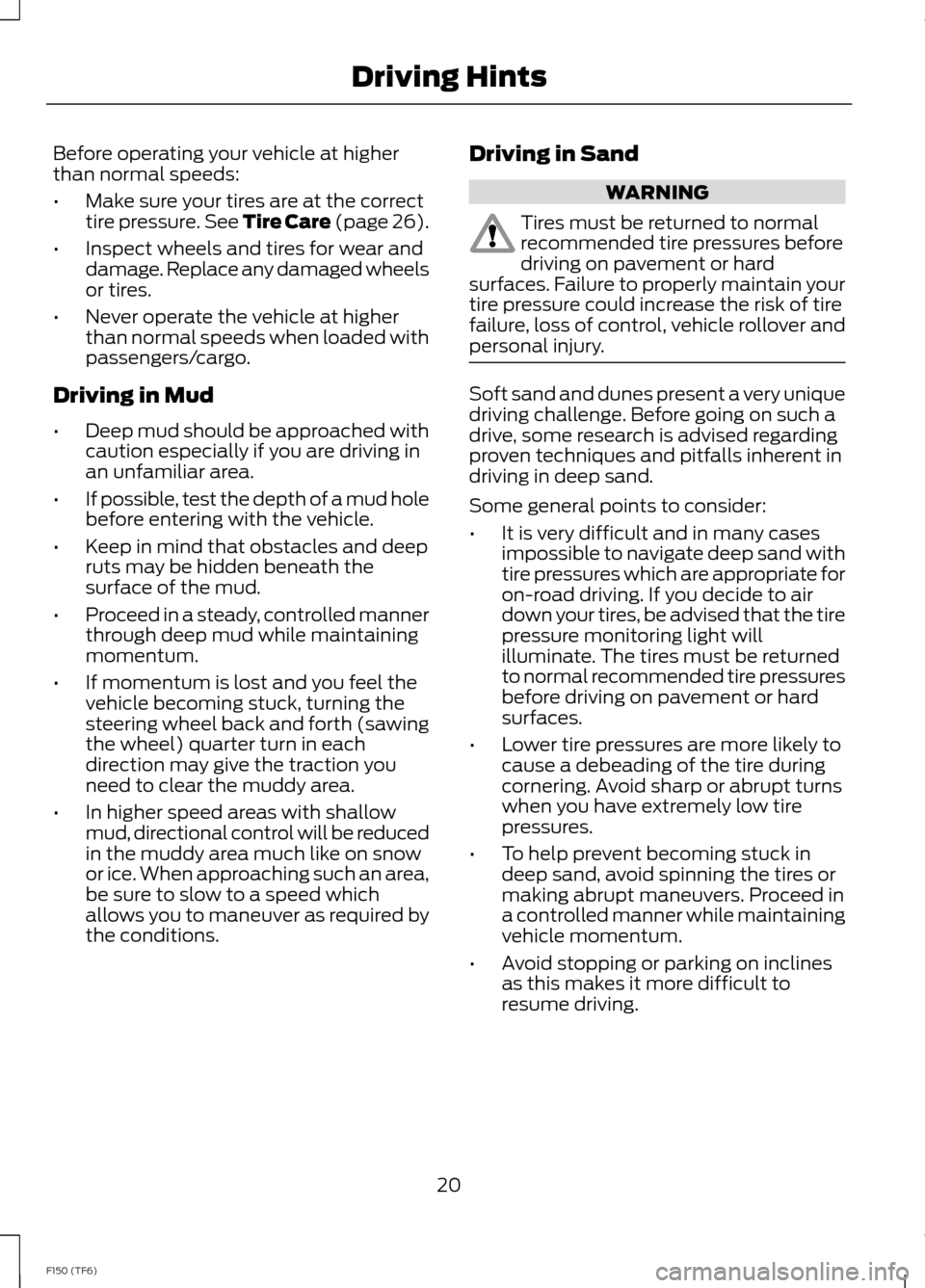
Before operating your vehicle at higherthan normal speeds:
•Make sure your tires are at the correcttire pressure. See Tire Care (page 26).
•Inspect wheels and tires for wear anddamage. Replace any damaged wheelsor tires.
•Never operate the vehicle at higherthan normal speeds when loaded withpassengers/cargo.
Driving in Mud
•Deep mud should be approached withcaution especially if you are driving inan unfamiliar area.
•If possible, test the depth of a mud holebefore entering with the vehicle.
•Keep in mind that obstacles and deepruts may be hidden beneath thesurface of the mud.
•Proceed in a steady, controlled mannerthrough deep mud while maintainingmomentum.
•If momentum is lost and you feel thevehicle becoming stuck, turning thesteering wheel back and forth (sawingthe wheel) quarter turn in eachdirection may give the traction youneed to clear the muddy area.
•In higher speed areas with shallowmud, directional control will be reducedin the muddy area much like on snowor ice. When approaching such an area,be sure to slow to a speed whichallows you to maneuver as required bythe conditions.
Driving in Sand
WARNING
Tires must be returned to normalrecommended tire pressures beforedriving on pavement or hardsurfaces. Failure to properly maintain yourtire pressure could increase the risk of tirefailure, loss of control, vehicle rollover andpersonal injury.
Soft sand and dunes present a very uniquedriving challenge. Before going on such adrive, some research is advised regardingproven techniques and pitfalls inherent indriving in deep sand.
Some general points to consider:
•It is very difficult and in many casesimpossible to navigate deep sand withtire pressures which are appropriate foron-road driving. If you decide to airdown your tires, be advised that the tirepressure monitoring light willilluminate. The tires must be returnedto normal recommended tire pressuresbefore driving on pavement or hardsurfaces.
•Lower tire pressures are more likely tocause a debeading of the tire duringcornering. Avoid sharp or abrupt turnswhen you have extremely low tirepressures.
•To help prevent becoming stuck indeep sand, avoid spinning the tires ormaking abrupt maneuvers. Proceed ina controlled manner while maintainingvehicle momentum.
•Avoid stopping or parking on inclinesas this makes it more difficult toresume driving.
20F150 (TF6)Driving Hints
Page 23 of 41
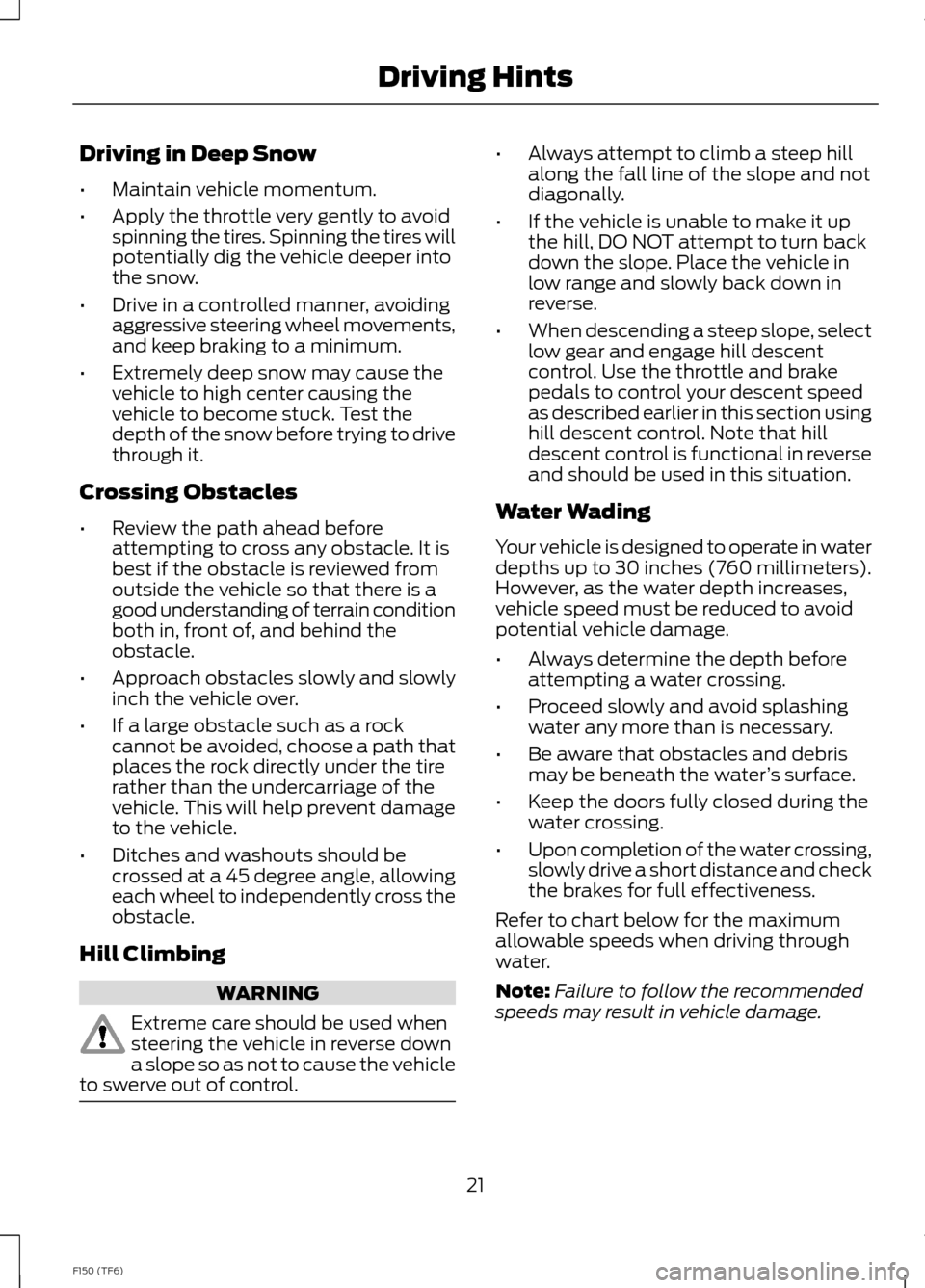
Driving in Deep Snow
•Maintain vehicle momentum.
•Apply the throttle very gently to avoidspinning the tires. Spinning the tires willpotentially dig the vehicle deeper intothe snow.
•Drive in a controlled manner, avoidingaggressive steering wheel movements,and keep braking to a minimum.
•Extremely deep snow may cause thevehicle to high center causing thevehicle to become stuck. Test thedepth of the snow before trying to drivethrough it.
Crossing Obstacles
•Review the path ahead beforeattempting to cross any obstacle. It isbest if the obstacle is reviewed fromoutside the vehicle so that there is agood understanding of terrain conditionboth in, front of, and behind theobstacle.
•Approach obstacles slowly and slowlyinch the vehicle over.
•If a large obstacle such as a rockcannot be avoided, choose a path thatplaces the rock directly under the tirerather than the undercarriage of thevehicle. This will help prevent damageto the vehicle.
•Ditches and washouts should becrossed at a 45 degree angle, allowingeach wheel to independently cross theobstacle.
Hill Climbing
WARNING
Extreme care should be used whensteering the vehicle in reverse downa slope so as not to cause the vehicleto swerve out of control.
•Always attempt to climb a steep hillalong the fall line of the slope and notdiagonally.
•If the vehicle is unable to make it upthe hill, DO NOT attempt to turn backdown the slope. Place the vehicle inlow range and slowly back down inreverse.
•When descending a steep slope, selectlow gear and engage hill descentcontrol. Use the throttle and brakepedals to control your descent speedas described earlier in this section usinghill descent control. Note that hilldescent control is functional in reverseand should be used in this situation.
Water Wading
Your vehicle is designed to operate in waterdepths up to 30 inches (760 millimeters).However, as the water depth increases,vehicle speed must be reduced to avoidpotential vehicle damage.
•Always determine the depth beforeattempting a water crossing.
•Proceed slowly and avoid splashingwater any more than is necessary.
•Be aware that obstacles and debrismay be beneath the water’s surface.
•Keep the doors fully closed during thewater crossing.
•Upon completion of the water crossing,slowly drive a short distance and checkthe brakes for full effectiveness.
Refer to chart below for the maximumallowable speeds when driving throughwater.
Note:Failure to follow the recommendedspeeds may result in vehicle damage.
21F150 (TF6)Driving Hints
Page 26 of 41
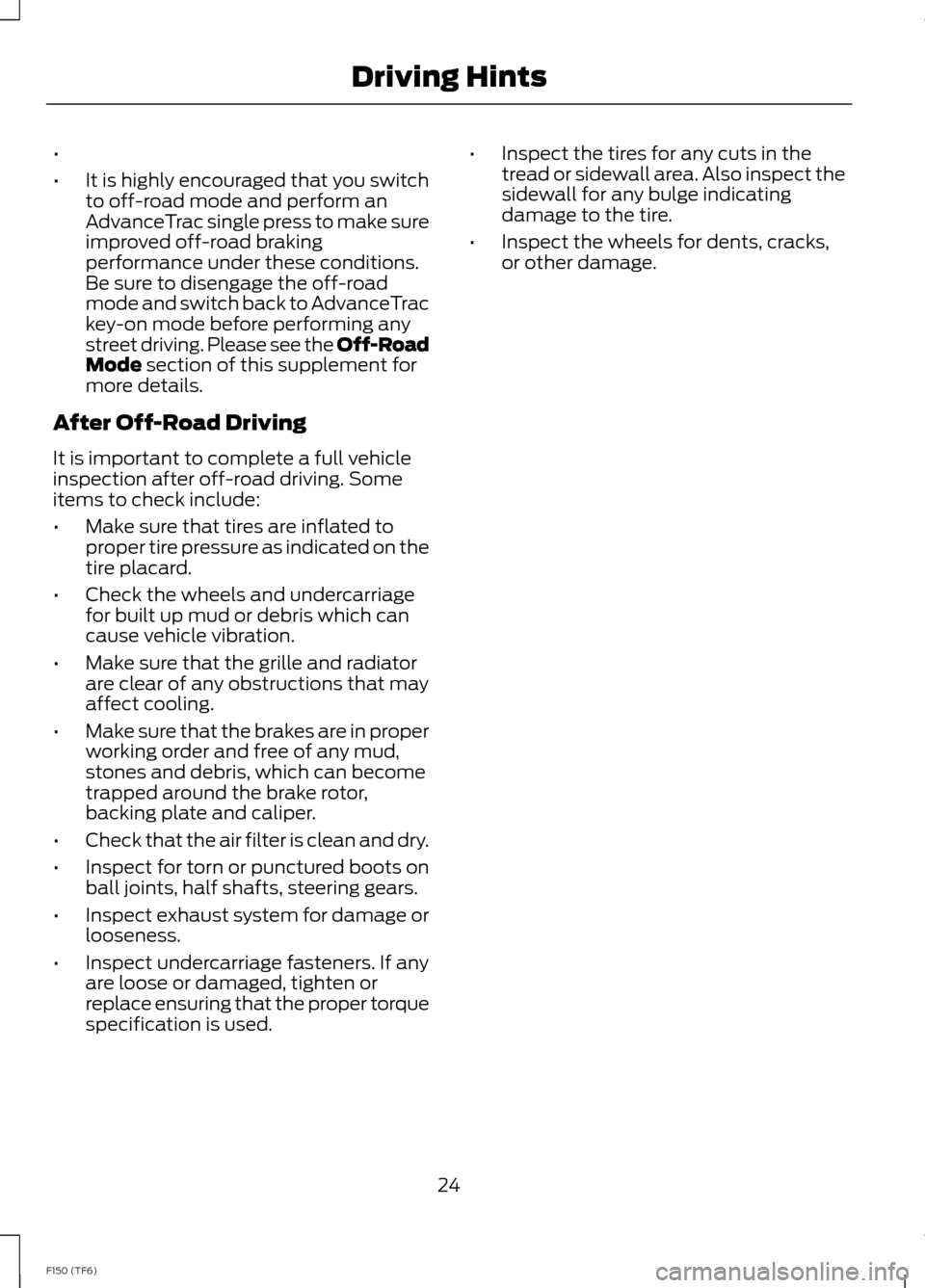
•
•It is highly encouraged that you switchto off-road mode and perform anAdvanceTrac single press to make sureimproved off-road brakingperformance under these conditions.Be sure to disengage the off-roadmode and switch back to AdvanceTrackey-on mode before performing anystreet driving. Please see the Off-RoadMode section of this supplement formore details.
After Off-Road Driving
It is important to complete a full vehicleinspection after off-road driving. Someitems to check include:
•Make sure that tires are inflated toproper tire pressure as indicated on thetire placard.
•Check the wheels and undercarriagefor built up mud or debris which cancause vehicle vibration.
•Make sure that the grille and radiatorare clear of any obstructions that mayaffect cooling.
•Make sure that the brakes are in properworking order and free of any mud,stones and debris, which can becometrapped around the brake rotor,backing plate and caliper.
•Check that the air filter is clean and dry.
•Inspect for torn or punctured boots onball joints, half shafts, steering gears.
•Inspect exhaust system for damage orlooseness.
•Inspect undercarriage fasteners. If anyare loose or damaged, tighten orreplace ensuring that the proper torquespecification is used.
•Inspect the tires for any cuts in thetread or sidewall area. Also inspect thesidewall for any bulge indicatingdamage to the tire.
•Inspect the wheels for dents, cracks,or other damage.
24F150 (TF6)Driving Hints
Page 28 of 41
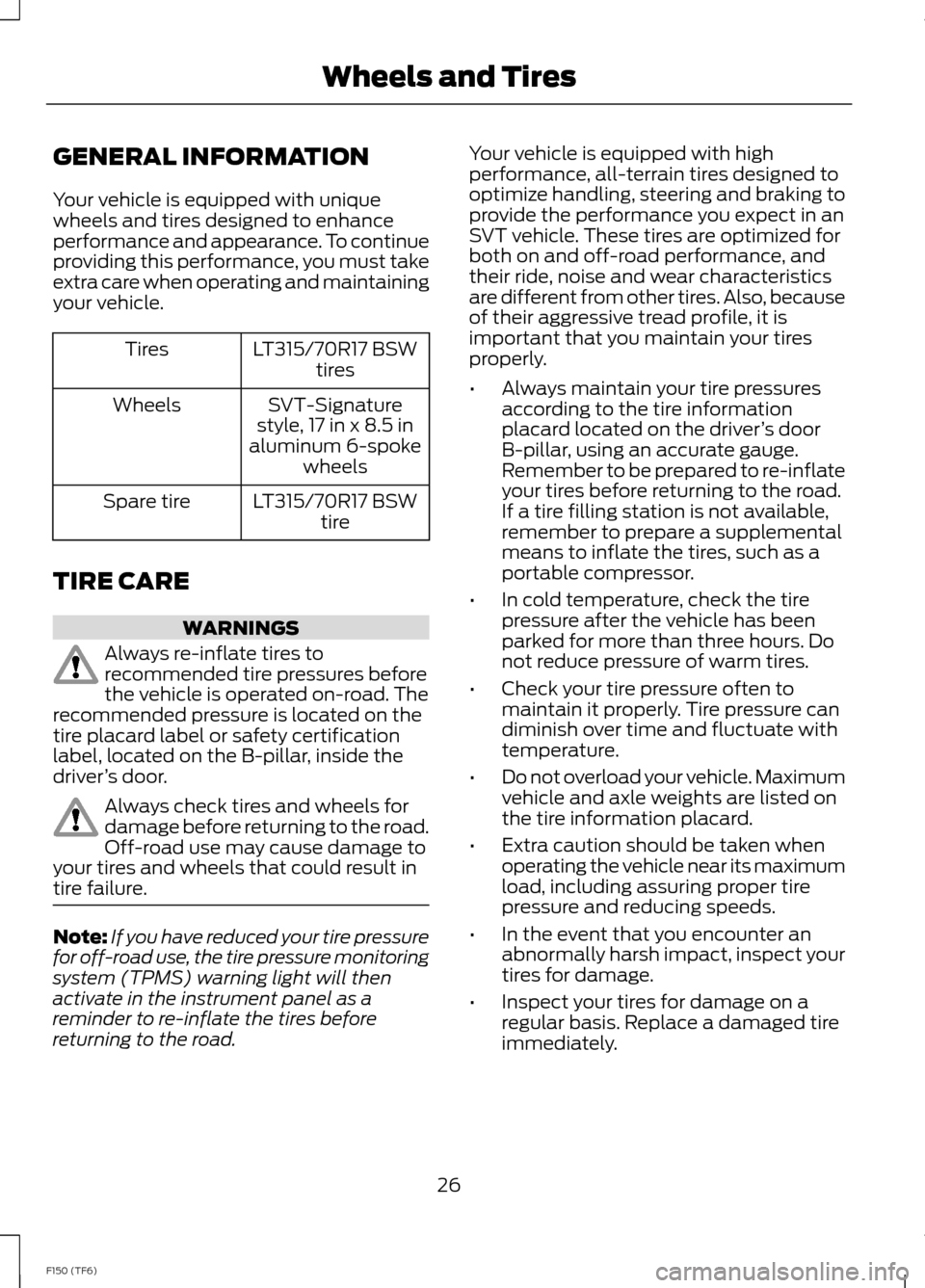
GENERAL INFORMATION
Your vehicle is equipped with uniquewheels and tires designed to enhanceperformance and appearance. To continueproviding this performance, you must takeextra care when operating and maintainingyour vehicle.
LT315/70R17 BSWtiresTires
SVT-Signaturestyle, 17 in x 8.5 inaluminum 6-spokewheels
Wheels
LT315/70R17 BSWtireSpare tire
TIRE CARE
WARNINGS
Always re-inflate tires torecommended tire pressures beforethe vehicle is operated on-road. Therecommended pressure is located on thetire placard label or safety certificationlabel, located on the B-pillar, inside thedriver’s door.
Always check tires and wheels fordamage before returning to the road.Off-road use may cause damage toyour tires and wheels that could result intire failure.
Note:If you have reduced your tire pressurefor off-road use, the tire pressure monitoringsystem (TPMS) warning light will thenactivate in the instrument panel as areminder to re-inflate the tires beforereturning to the road.
Your vehicle is equipped with highperformance, all-terrain tires designed tooptimize handling, steering and braking toprovide the performance you expect in anSVT vehicle. These tires are optimized forboth on and off-road performance, andtheir ride, noise and wear characteristicsare different from other tires. Also, becauseof their aggressive tread profile, it isimportant that you maintain your tiresproperly.
•Always maintain your tire pressuresaccording to the tire informationplacard located on the driver’s doorB-pillar, using an accurate gauge.Remember to be prepared to re-inflateyour tires before returning to the road.If a tire filling station is not available,remember to prepare a supplementalmeans to inflate the tires, such as aportable compressor.
•In cold temperature, check the tirepressure after the vehicle has beenparked for more than three hours. Donot reduce pressure of warm tires.
•Check your tire pressure often tomaintain it properly. Tire pressure candiminish over time and fluctuate withtemperature.
•Do not overload your vehicle. Maximumvehicle and axle weights are listed onthe tire information placard.
•Extra caution should be taken whenoperating the vehicle near its maximumload, including assuring proper tirepressure and reducing speeds.
•In the event that you encounter anabnormally harsh impact, inspect yourtires for damage.
•Inspect your tires for damage on aregular basis. Replace a damaged tireimmediately.
26F150 (TF6)Wheels and Tires